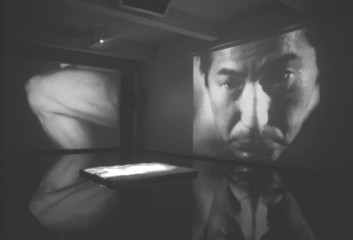|
|
|
|
| NALINI MALANI |
| Born 1946 in Karachi, India. Lives and works in Bombay, India |
| |
 |
| Nalini Malani, “Hamletmachine” (installation view), 1999/2000. © Imamura Kaoru |
| |
|
Nalini Malani was born in 1946 in Karachi at the time India and Pakistan were partitioned. Trained as a painter and print-maker, Malani received her education at Sir J.J. School of Art, Bombay, in 1969, and at Atelier Friedlander, Paris, France, from 1970-73. Working with video was an answer for several women artists during the 1990s, who felt an acute need to address a wider public. The political exigencies of the situation in India – the vandalism and destruction of the 16th century Babri Masjid Mosque (1992), riots and sectarian violence, and the euphoria of nuclear empowerment (1998) – demanded a new way of foregrounding the situation which was growing particularly oppressive for women. Malani started to work with video in 1991 when she recorded her installation “City of Desires;” an ephemeral, continuous drawing on the walls of Gallery Chemould in Bombay, made in protest against the rise of Hindu fundamentalism. Her video works have been an expansion of her practices in drawing and painting. In her multi-media installations, she often makes single cell animated drawings that bleed and stain. Foregrounding the dispossessed of the earth, she uses texts which reflect on violence, pain, and suffering in the name of nationalism and religion. Working in collaboration with theater artists, Malani has made installations for Heiner Müller's Medeamaterial, where Jason appeared on a monitor in an interactive video conferencing mode (1993). And in The Job by Bertolt Brecht, the entire story unfurls in animation (1997). Some of her large scale works include: “The Sacred and The Profane” (a shadow play from 1998); “Remembering Toba Tek Singh” (an video installation from 1998); “Hamletmachine” (a video play from 2002); “Transgressions” (a video/shadow play); “Game Pieces” (a video/shadow play from 2003); and “Unity in Diversity” (2003). Malani has shown solo exhibitions at: The Prince of Wales Museum (Bombay, India,1999); The New Museum of Contemporary Art (New York, USA, 2002); Apeejay Media Gallery (New Delhi, India, 2002); and Bose Pacia Modern (New York, USA, 2004). A selection of the international venues where her presentations have been shown include: World Wide Video Festival (Amsterdam, The Netherlands, 1998); Gwangju Biennale (Korea, 2000); Century City (Tate Modern, London, United Kingdom, 2001); Unpacking Europe (Museum Boijmans Van Beuningen, Rotterdam, The Netherlands, 2002); Voiceovers (Art Gallery of New South Wales, Sydney, Australia, 1999); Asia-Pacific Triennial (Brisbane, Australia, 2002); Poetic Justice (8th International Istanbul Biennial, Turkey, 2003); and La Nuit Blanche (Paris, France, 2004). |
| |
| Contribution: Participates in Station 2: Aarhus Art Building, Aarhus, with “Hamletmachine,” 1999/2000. Video play, 20 min. Courtesy of the artist. Based on the text of Heiner Müller's play Hamletmachine (1977), the video play manifests the rise of Hindu fundamentalism in India, which reached its peak with the frenzied violence of fanatics who brought down the 16th century Babri Masjid Mosque in December 1992. The growing unrest that followed this destruction provided the Hindu fanatics with an opportunity to attack and pillage the shanty towns of the minority Muslim population in a clear case of land grab in Mumbai. Overnight, slum colonies were burnt to cinders. The railway stations were filled with Muslims trying to catch any train that might take them away to the safety of their villages. |
| |
|
|
|
|